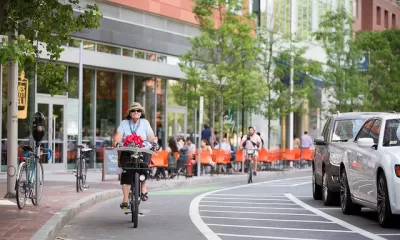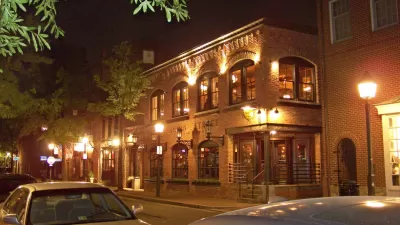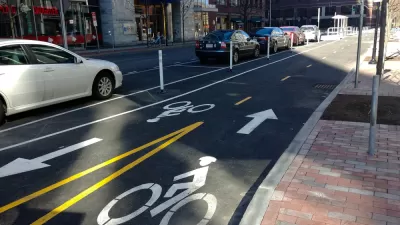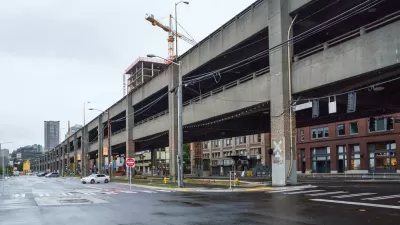I don't bike, but I still feel safer on streets with bike lanes. This essay explains why.

I never learned to ride a bicycle. And yet I am an active member of an organization dominated by bicycle riders, and is often focused on increasing the number of urban bike lanes. Why?
Because I believe that walkers benefit from bike lanes as well. Here's why: when a traffic lane is devoted to bicycles and taken away from cars, this means that the remaining lanes are either narrower or there are fewer of them. As a matter of common sense, it seems obvious that motorists drive more slowly on narrower streets. And when motorists drive more slowly, they are less dangerous to walkers or to each other. For example, if you are a walker hit by a car going 20 miles per hour, you have a 5 percent chance of death. By contrast, if you are hit by a car going 40 miles per hour, you have an 85 percent chance of death. Thus, a street design that calms traffic is likely to reduce the amount of injuries and deaths caused by vehicle traffic. It follows that bicycle lanes reduce danger to pedestrians by calming traffic.*
Walkers benefit even more when a bike lane is separated from auto traffic by a small refuge island or similar structure. In such cases, a pedestrian can cross to the island and then cross again from the refuge island to the sidewalk across the street. Where this is the case, a walker need not cross as many lanes of traffic at a time; instead, she can make the short crossing to the island, than a second longer crossing to the sidewalk. It seems to me that this two-step crossing is a bit safer for the walker. When I cross at a traffic light, I always have to worry that the light might change while I am in the street, increasing my risk of a head-on collision with a car. But the fewer seconds I spend crossing the street at an intersection, the lower this risk is. So if a two-step process reduces the number of seconds I spend crossing at a time, it may reduce my risk of being victimized by changing traffic lights.
Unfortunately, not all pedestrians in my city agree with me. A few weeks ago, I met someone who does not drive, but who complained about how much she hated bicycle lanes; she somehow felt that bikes were more dangerous than cars. This fear is somewhat understandable, because my acquaintance had become used to cars, and was not yet used to bicycles. However, her fear is not rationally based. In 2016, 148 New York City pedestrians (and 18 cyclists) were killed by motor vehicles. By contrast, not one pedestrian was killed by a cyclist. It follows that if (as I suspect) bike lanes in fact make pedestrians safer, this benefit outweighs any risk to pedestrians caused by additional cycling.
*I note that motorists often oppose bicycle lanes for this very reason, asserting that they increase congestion. But speed and congestion are not the same thing; when I am driving, I suffer far more when I am trapped in a traffic jam at a high-speed arterial or interstate highway than I do when I am driving at a slow, even 20 mph pace for streets designed for 20 mph traffic.

Study: Maui’s Plan to Convert Vacation Rentals to Long-Term Housing Could Cause Nearly $1 Billion Economic Loss
The plan would reduce visitor accommodation by 25,% resulting in 1,900 jobs lost.

North Texas Transit Leaders Tout Benefits of TOD for Growing Region
At a summit focused on transit-oriented development, policymakers discussed how North Texas’ expanded light rail system can serve as a tool for economic growth.

Why Should We Subsidize Public Transportation?
Many public transit agencies face financial stress due to rising costs, declining fare revenue, and declining subsidies. Transit advocates must provide a strong business case for increasing public transit funding.

How to Make US Trains Faster
Changes to boarding platforms and a switch to electric trains could improve U.S. passenger rail service without the added cost of high-speed rail.

Columbia’s Revitalized ‘Loop’ Is a Hub for Local Entrepreneurs
A focus on small businesses is helping a commercial corridor in Columbia, Missouri thrive.

Invasive Insect Threatens Minnesota’s Ash Forests
The Emerald Ash Borer is a rapidly spreading invasive pest threatening Minnesota’s ash trees, and homeowners are encouraged to plant diverse replacement species, avoid moving ash firewood, and monitor for signs of infestation.
Urban Design for Planners 1: Software Tools
This six-course series explores essential urban design concepts using open source software and equips planners with the tools they need to participate fully in the urban design process.
Planning for Universal Design
Learn the tools for implementing Universal Design in planning regulations.
Ascent Environmental
Borough of Carlisle
Institute for Housing and Urban Development Studies (IHS)
City of Grandview
Harvard GSD Executive Education
Toledo-Lucas County Plan Commissions
Salt Lake City
NYU Wagner Graduate School of Public Service






























